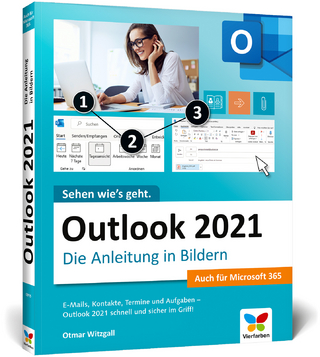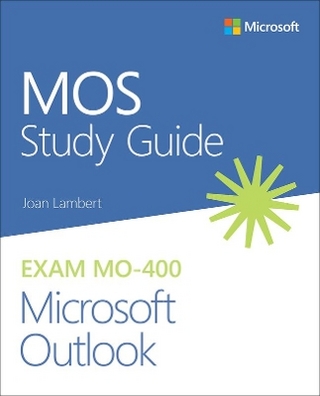
Developing Applications Using Outlook 2000, CDO, Exchange, and Visual Basic
Addison Wesley (Verlag)
978-0-201-61575-3 (ISBN)
- Titel ist leider vergriffen;
keine Neuauflage - Artikel merken
"This is the 'must have' book for programming with Outlook and CDO. This book provides the details, tips, and cautions that can save you time and frustration when building collaborative applications. So if you like 'the best' in your technical library, get this book." --Deborah Kurata, InStep Technologies, Inc. Written for IT developers who build collaborative and workflow applications, this book provides a comprehensive reference to working with Microsoft's powerful collaborative development environment, including Outlook 2000, Exchange Server, Visual Basic, and the Collaboration Data Objects (CDO) Library. It demonstrates ways in which these technologies can be tied together into effective business solutions--from small-scale groupware to large-scale enterprise-wide systems. Developing Applications using Outlook 2000, CDO, Exchange, and Visual Basic offers an overview of the Microsoft collaborative landscape, and then examines each element of that environment in detail. Numerous examples showcase the applications made possible with these technologies and demonstrate VBScript coding techniques.
You will find in-depth information on such important topics as: *properties, methods, and events available in Outlook 97, 98, and 2000 *the Outlook 2000 object model *working with Outlook 2000 mail, calendar, task, and address book capabilities *VBA and COM add-ins *using Outlook Forms and VBScript *Outlook web access *the Forms 2.0 to HTML converter tool *the CDO rendering object model *Exchange agents and routing objects In addition, this book shows how a number of outside technologies can extend the capabilities of the Outlook/Exchange development environment, including Active Directory (ADSI) services, SQL Server, and ActiveX Data Objects (ADO). The examples include approving purchase order reports using Exchange, maintaining a corporate directory using Outlook and SQL Server, and building an eCommerce application with Exchange and SQL Server. 0201615754B12122002
Raffaele Piemonte is Chief Technology Officer for ingredients.com, a specialty beauty and personal care eRetailer. While writing this book he was Senior Manager at Micro Modeling Associates, Inc. (MMA). As MMA's Visual Basic Product Champion, he created standards and naming conventions and standardized on third party tools. Raffaele has extensive expertise developing Microsoft Outlook and other Microsoft-based client/server applications. He is a frequent contributor to Databased Advisor and Databased Web Advisor, and his articles are available on TechNet and the Microsoft Web site. Scott Jamison is a Managing Consultant at Plural, Inc., the 1999 Microsoft Solution Provider Partner of the Year. He lectures and writes extensively on a wide array of development topics, including architectures, development techniques, and Microsoft Exchange. He is a monthly columnist for Exchange & Outlook magazine. 0201615754AB04062001
Foreword.
Preface.
Acknowledgments.
I. GETTING STARTED.
= 1. Overview of the Collaboration and Communication Architecture.
Introduction to Collaborative Systems.
Outlook 2000.
Collaboration Data Objects.
Using Outlook versus CDO.
Microsoft Exchange Server.
Overview of MAPI.
Other Collaboration Components.
How the Pieces Fit Together.
Summary.
II. MICROSOFT OUTLOOK 2000.
= 2. Outlook Forms and VBScript.
Overview of Outlook Forms.
Putting Code behind an Outlook Form.
Versioning.
Password Protection.
Saving Outlook Forms.
Distribution.
Accessing Forms through Code.
Overview of Forms/VBScript Limitations.
Changing Forms for Existing Items.
Tips for Outlook Forms/VBScript Development.
Displaying Information: Views.
Reporting.
Additional Examples.
Summary.
3. The Outlook 2000 Object Model.
The Object Model.
Application Object.
User Interface Objects.
Accessing Outlook Data.
Additional Outlook Development Features.
Accessing the Mail Control Panel in Code.
Integration with Microsoft Access.
Conclusion.
4. MailItems and PostItems.
MailItems.
PostItems.
MailItem and PostItem Properties.
MailItem and PostItem Methods.
MailItem and PostItem Events.
Summary.
5. AppointmentItems and TaskItems.
The Outlook Calendar: Appointments and Meetings.
How AppointmentItems and MeetingItems Work Together.
AppointmentItem Properties.
AppointmentItem Methods.
AppointmentItem Events.
Creating Custom Appointment Forms.
The Outlook Tasks List: TaskItems.
How TaskItems Work.
TaskItem Properties.
TaskItem Methods.
TaskItem Events.
Summary.
6. Contacts and Distribution Lists.
Contacts, Recipients, and AddressEntries.
Contact Items.
The Recipient Object.
Distribution List Items.
Summary.
7. VBA, COM Add-Ins, and Custom Property Pages.
Visual Basic for Applications.
COM Add-Ins.
The COMAddIns Collection.
Using COM Add-Ins to Implement Property Pages.
Deployment.
Summary.
III. COLLABORATION DATA OBJECTS AND EXCHANGE.
8. Microsoft Exchange Server.
Introduction.
Exchange's Core Components.
Other Exchange Services.
Setting Up Exchange.
Exchange Administrator Program.
Configuring Mailboxes and Public Folders.
Exchange Objects.
Summary.
9. Collaboration Data Objects.
What CDO Provides.
The CDO Objects.
At the Top: The Session Object.
The InfoStores Collection.
Folders and the Folder Object.
Messages and the Message Object.
Discussion Group Support.
Calendar Support.
Address Books.
The Address Book Objects.
The AddressEntry Object.
CDO for NT Server.
CDO for Windows 2000.
CDO for Exchange Platinum.
Summary.
10. Accessing Exchange Using the Web.
Outlook Web Access.
The Frameset Design-Time Control.
The HTML Form Converter.
Exchange Web Example.
The CDO Rendering Library.
Security Considerations.
Server Location Considerations.
Web Access Performance.
Summary.
11. Exchange Agents.
Tech Check.
Uses for Exchange Agent Scripts.
Assigning Permissions.
Events.
Behind the Scenes.
Asynchronous Execution.
Example of Exchange Agent Calling a COM Component.
Creating an Agent.
Installing an Agent.
Debugging Scripts.
Under the Hood.
Limitations.
More Examples.
Conclusion.
12. Exchange Server Routing Objects.
Tech Check.
Using Routing Objects for Workflow.
Architecture of Routing Objects.
The Routing Engine.
The Routing Wizard.
Routing Objects Object Model.
Process Map Actions.
Creating the Process Map.
Tips and Caveats for Successful Routing.
Conclusion.
IV. MISCELLANEOUS TOPICS.
13. Outlook or CDO: Deciding Which to Use.
Okay, So Which One Do I Use?
The Object Model Structures.
Comparison of the Two Models.
Summary.
14. Using Active Directory Services Interfaces with Microsoft Exchange.
Tech Check.
The Lightweight Directory Access Protocol.
The Object Schema.
The ADSI Object Model.
ActiveX Data Objects.
Example: Changing Employee Information.
Conclusion.
15. Data Access Technologies: ActiveX Data Objects and OLE DB.
The Exchange and Outlook Message Stores.
Universal Data Access.
Using ADO to Read Contacts from a Database.
Accessing Data with an Exchange OLE DB Provider.
Summary.
16. Site Server and Knowledge Management.
Tech Check.
Exchange and Site Server.
Site Server Implementing Index Server.
Using Site Server to Index Data.
Working with Catalogs.
Site Server Configuration and Administration.
The MSSearch.Query Search Object.
Conclusion.
17. Using Microsoft Transaction Server with Exchange Agents.
Tech Check.
Overview of Microsoft Transaction Server.
HOW MTS Relates to Exchange.
Installing and Implementing MTS.
Conclusion.
V. SAMPLE APPLICATIONS.
18. The CdoExplorer Application.
Overview of the Application.
A Look at the Code.
Building the Folder Tree.
Listing Properties.
Summary.
19. A Group Scheduling Application.
Description of the Business Problem.
Create a Custom Outlook Form.
Publish the Form to the Organizational Forms Library.
Creating the Visual Basic Application.
Putting It All Together.
Summary.
20. An Outlook Calendar Viewer Application.
Tech Check.
Description of the Business Problem.
Detailed Code Highlights.
Conclusion.
21. A Purchase Order Application Using Routing Objects.
Tech Check.
Description of the Business Problem.
Architecture of the Application.
Summary.
22. A Corporate Directory Maintenance Application.
Description of the Business Problem.
The Application in Action.
Initializing the EntryIDs.
Updating the Address Book.
Viewing Updated Properties.
Putting It All Together.
Summary.
23. An eCommerce Workflow Application.
Tech Check.
A Closer Look at the eCommerce Application.
Behind the Scenes: the Code.
Summary.
Additional References.
Index. 0201615754T04062001
| Erscheint lt. Verlag | 22.10.1999 |
|---|---|
| Verlagsort | Boston |
| Sprache | englisch |
| Maße | 233 x 187 mm |
| Gewicht | 1012 g |
| Themenwelt | Informatik ► Netzwerke ► Mail Server |
| Informatik ► Office Programme ► Outlook | |
| ISBN-10 | 0-201-61575-4 / 0201615754 |
| ISBN-13 | 978-0-201-61575-3 / 9780201615753 |
| Zustand | Neuware |
| Haben Sie eine Frage zum Produkt? |
aus dem Bereich

